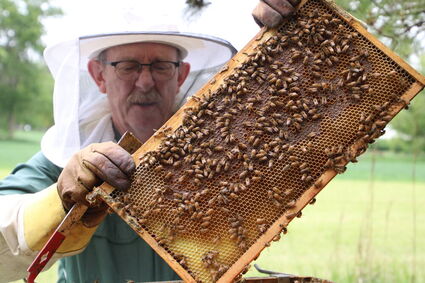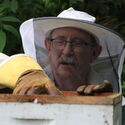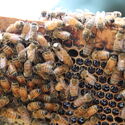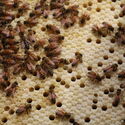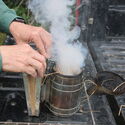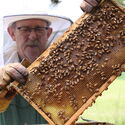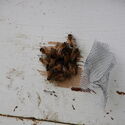King of the colony
Dave Vander Broek enjoys beekeeping hobby
September 9, 2021
Unknowing trespassers who venture into a certain tree grove on the south side of Hartley might find themselves sprinting in the other direction.
Buzzing along the tree line is the city's lone beehive. Its keeper is Dave Vander Broek, who has maintained colonies there since 2016.
The Hartley man has grown quite fond of his many winged friends over the years.
"It's fascinating that the bees know so much," he said.
Vander Broek got interested in beekeeping after reading a magazine article about their plight. Pesticides, habitat loss and deadly invasive mites have significantly depleted bee populations in the United States over the past decade, which made him wonder if he could lend a helping hand.
After doing some research, Vander Broek jumped in feet first with two hives. He's down to one now, but has no plans to quit.
He checks on the colony weekly to make sure the queen is still alive and producing eggs. Donning a multi-layered mesh jacket, gloves and a screened hood, Vander Broek is protected against stings. He also makes sure to close the ends of his pants legs with Velcro straps.
Failing to properly seal his getup comes with immediate consequences.
"I left an opening in my hood once, and all of sudden it was like, 'Dang, those bees look close,' " he said. "The stings don't hurt that bad, but they can be irritating. For me, I'll swell up real bad and I don't like that."
The first thing Vander Broek does when he approaches the hive is puff smoke into each entrance hole. Doing so disrupts pheromones the bees use for communication, making them less aggressive.
Once the insects are subdued, Vander Broek opens the top to access the internal frames. He has to separate each one by using a pry bar thanks to the bees' engineering – every crack inside the hive is sealed with an extremely sticky substance called propolis, which they collect from trees and other plants.
"It's almost like wood glue in a way," Vander Broek explained. "They absolutely hate it when there's a crack that's not filled."
Once inside, Vander Broek scans the frames to make sure the bees' meticulously crafted cells are filled with eggs and larva. He eventually locates the queen before closing up shop.
However, finding her is no small feat – each hive contains approximately 20,000 bees, and only a single white dot on her back gives the monarch away. Vander Broek doesn't dawdle once he sees she's alive and well.
"You know she's doing a good job when she's filling out most of the frames with eggs. Once you see that, you can leave them alone," he said. "The main cause of queen mortality is beekeepers. I try not to check them more than once a week, because every time you check them you upset them."
The queen can lay between 1,500-1,700 eggs each day beginning in March. Her offspring only live approximately 30-40 days, so the population completely flips several times each season. The queen's egg output must keep up with the mortality rate to keep the hive viable.
If she dies and doesn't get replaced, the hive will collapse. Vander Broek can also replace a queen if she's not producing enough eggs – he simply buys a new one for $35 and then kills the old one.
"You need to leave the hive without a queen for 24 hours so they know something is wrong, otherwise they will kill the new one if you put her in there right away," he said.
Aside from the queen, two other kinds of bees populate the hive.
Drones are male bees that have no stingers and only exist to provide semen to the queen. The female worker bees do everything else – from taking care of the brood and collecting pollen to feeding the queen and keeping her hydrated.
In addition to a healthy monarch and bountiful brood, the hive needs ample space to be successful. Each box is filled with 10 frames and once they're filled, Vander Broek adds a new one.
The bees will begin a process called swarming if they feel like they're running out of room. Worker bees will start making larger cells called queen cells. The current queen will fill them with eggs, and then the workers will feed the larvae a substance called "royal jelly" so they become queens.
The old queen leaves the hive, along with half its population, once her heirs are ready.
"That's in their genetics, because that's how they survive. If this was a trunk of a tree, they'd have it completely populated and would need to move on," Vander Broek explained.
Low egg production and spatial constraints aren't the only things the hobby beekeeper needs to look out for. Varroa mites have become the Trojan horse for beehives across the country.
The parasite latches onto a bee and pierces its exoskeleton to drink bodily fluid. The wound leaves the bee more susceptible to viral infections and subsequent death.
"It's so invasive that it's common now," Vander Broek said.
He has to test the hive monthly to monitor mite numbers. He fills a special device with antifreeze and alcohol, then loads it with 300 younger bees. More solution is added to kill the bees and the container gets shaken up. The mites fall to the bottom and he then tallies up the total.
A rate of two mites per 100 bees is considered healthy. If there's more, special medicine can be administered in the hive to control further outbreaks.
Vander Broek uses Carniolan bees in his hive. Special species are being bred to attack mites and mitigate mass population losses.
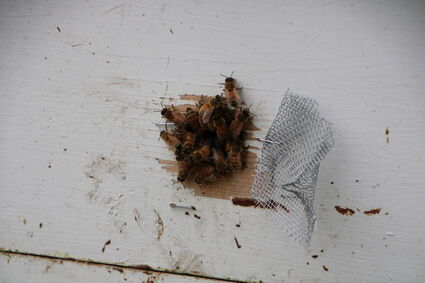
NICK PEDLEY/SENTINEL-NEWS
Bees exit one of the hive's holes while Vander Broek completes a weekly well check.
"There's one call 'ankle-biters.' When they sense a bee with mites, they'll bite off their legs and then the mite falls off," he said.
Vander Broek's bees primarily collect pollen from wildflowers in ditches and domestic flowers in Hartley. He lets them keep all the honey they produce to survive the winter.
Though he doesn't collect the golden good stuff regularly, he does have some on hand.
"The irritating thing about my honey is that it crystalizes so bad," he said. "That's not a big deal, we just heat it up at 115 degrees or less. It's just kind of a process we have to do in the kitchen."
Vander Broek suggested beekeeping to anyone who's willing to put in the time and money. It took $500-$600 to get his tiny operation going during the first year, but much less ever since.
"When it's working well, it's really fun to do it," he said.

